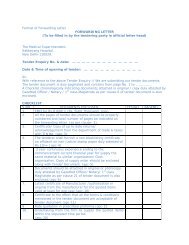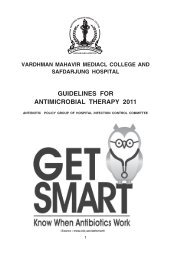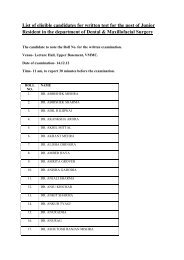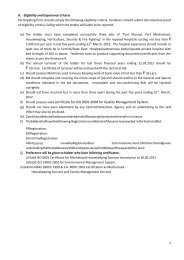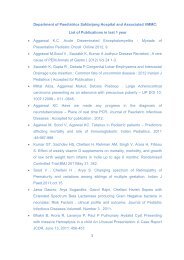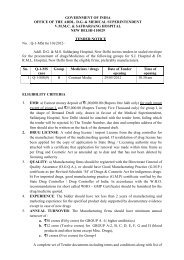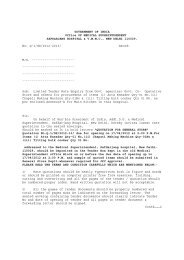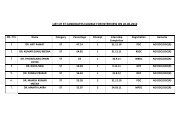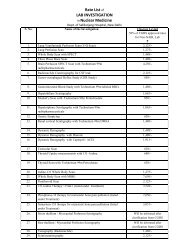Guidelines for INFECTION CONTROL POLICY - Safdarjung Hospital
Guidelines for INFECTION CONTROL POLICY - Safdarjung Hospital
Guidelines for INFECTION CONTROL POLICY - Safdarjung Hospital
Create successful ePaper yourself
Turn your PDF publications into a flip-book with our unique Google optimized e-Paper software.
Drinking WaterBacteriological surveillance is to be done monthly. Potable water testing is routinely carried out<strong>for</strong> bacterial cultures in laboratory from all patient care units, hospital kitchen, canteens andhostels – once in a month.Centralised Sterilised Supplies DepartmentAir and surface sterility is monitored from sterile zone. Bowie Dick test and use of biologicalindicators <strong>for</strong> steam sterilisation is carried out. Disinfectant screening is also done. Recordsto be kept by CSSD.PASSIVE SURVEILLANCEReporting of hospital acquired infectionsPassive Clinical ReportingIt will be mandatory <strong>for</strong> clinicians to fill the prescribed <strong>for</strong>m <strong>for</strong> every admitted patient and the<strong>for</strong>m may be sent to Infection Control Nurse (ICN).Passive Microbiological ReportingIn an event of clustering of cases passive surveillance is initiated. Respective clinicians arein<strong>for</strong>med about the suspected clustering and surveillance specimens are collected. The reportthus generated from the study is sent to the concerned physicians and surgeons. This is beingdone regularly.HAND HYGIENE• Training and compliance needs to be monitored. Availability of hand rubs, Soaps handtowels and water should be ensured. Foot operated and wall mounted dispensing stationsare required. Hand hygiene training programme <strong>for</strong> doctors, nursing staff, students andhousekeeping staff is done regularly once a month <strong>for</strong> each category of staff. Handhygiene compliance is not yet initiated.MULTIDISCIPLINARY CONTINUING EDUCATION PROGRAMMEContinuous education programme is conducted on regular basis <strong>for</strong> all categories of staffensuring each staff attends the programme at least once in three months.DIS<strong>INFECTION</strong> <strong>POLICY</strong>DIS<strong>INFECTION</strong>Disinfection is a process where most microbes are removed from defined object or surface,except spores.Disinfectants can be classified according to their ability to destroy different categoriesof micro-organisms:• High Level disinfectants : glutaraldehyde 2%, ethylene oxide• Intermediate Level disinfectant : alcohols, chlorine compounds, hydrogen peroxide,chlorhexidene, glutaraldehyde(short term exposure)• Low level disinfectants : benzalkonium chloride, some soapsGENERAL GUIDELINES FOR DIS<strong>INFECTION</strong>:Critical instruments/equipments (that are those penetrating skin or mucous membrane) shouldundergo sterilisation be<strong>for</strong>e and after use. e.g. surgical instruments.10



